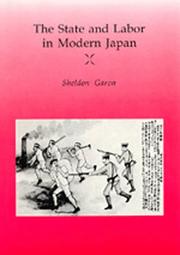| Listing 1 - 10 of 11 | << page >> |
Sort by
|

ISBN: 0691044880 Year: 1997 Publisher: Princeton, NJ ; Chichester, UK Princeton University Press
Abstract | Keywords | Export | Availability | Bookmark
 Loading...
Loading...Choose an application
- Reference Manager
- EndNote
- RefWorks (Direct export to RefWorks)
Social control --- History. --- Japan --- Social policy. --- Social conditions --- Social policy --- 1868-.... --- History --- Japan - Social conditions - 1868 --- -Japan --- -Social control --- Japan - Social conditions - 1868-

ISBN: 069100191X 9780691001913 Year: 1998 Publisher: Princeton Princeton University Press
Abstract | Keywords | Export | Availability | Bookmark
 Loading...
Loading...Choose an application
- Reference Manager
- EndNote
- RefWorks (Direct export to RefWorks)
Social control --- Social control. --- Social history. --- Social policy. --- History. --- Since 1868. --- Japan --- Japan. --- Social conditions --- J4000.70 --- J4600.70 --- J4120 --- J4176 --- Social conflict --- Sociology --- Liberty --- Pressure groups --- History --- Japan: Social history, history of civilization -- Kindai (1850s- ), bakumatsu, Meiji, Taishō --- Japan: Politics and law -- history -- Kindai (1850s- ), bakumatsu, Meiji, Taishō --- Japan: Sociology and anthropology -- social psychology and social-cultural phemomena --- Japan: Sociology and anthropology -- gender roles, women, feminism --- Japan: Sociology and anthropology -- social psychology and social-cultural phenomena
Book
ISBN: 9780691135991 0691135991 0691159580 1400839408 1283290901 9786613290908 9781400839407 6613290904 9781283290906 9780691159584 Year: 2011 Publisher: Princeton, NJ
Abstract | Keywords | Export | Availability | Bookmark
 Loading...
Loading...Choose an application
- Reference Manager
- EndNote
- RefWorks (Direct export to RefWorks)
If the financial crisis has taught us anything, it is that Americans save too little, spend too much, and borrow excessively. What can we learn from East Asian and European countries that have fostered enduring cultures of thrift over the past two centuries? Beyond Our Means tells for the first time how other nations aggressively encouraged their citizens to save by means of special savings institutions and savings campaigns. The U.S. government, meanwhile, promoted mass consumption and reliance on credit, culminating in the global financial meltdown. Many economists believe people save according to universally rational calculations, saving the most in their middle years as they plan for retirement, and saving the least in welfare states. In reality, Europeans save at high rates despite generous welfare programs and aging populations. Americans save little, despite weaker social safety nets and a younger population. Tracing the development of such behaviors across three continents from the nineteenth century to today, this book highlights the role of institutions and moral suasion in shaping habits of saving and spending. It shows how the encouragement of thrift was not a relic of indigenous traditions but a modern movement to confront rising consumption. Around the world, messages to save and spend wisely confronted citizens everywhere--in schools, magazines, and novels. At the same time, in America, businesses and government normalized practices of living beyond one's means. Transnational history at its most compelling, Beyond Our Means reveals why some nations save so much and others so little.Some images inside the book are unavailable due to digital copyright restrictions.
AA / International- internationaal --- US / United States of America - USA - Verenigde Staten - Etats Unis --- 339.311.1 --- 339.320 --- 331.162.24 --- Spaarneiging. --- Consumptie: algemeenheden. Wet van de vraag in verband met de consumptie. Consumptiebehoefte. Behoeftetheorie. --- Geschiedenis van de spaarinstellingen. --- Thriftiness --- Frugality --- Capital movements. --- Saving and investment. --- Capital flight --- Capital flows --- Capital inflow --- Capital outflow --- Flight of capital --- Flow of capital --- Movements of capital --- Balance of payments --- Foreign exchange --- International finance --- Finance, Personal --- Accumulation, Capital --- Capital accumulation --- Capital formation --- Investment and saving --- Saving and thrift --- Capital --- Supply-side economics --- Wealth --- Investments --- Saving and investment --- Capital movements --- E-books --- Spaarneiging --- Consumptie: algemeenheden. Wet van de vraag in verband met de consumptie. Consumptiebehoefte. Behoeftetheorie --- Geschiedenis van de spaarinstellingen
Book
ISBN: 0520059832 9780520059832 Year: 1988 Publisher: Berkeley University of California press
Abstract | Keywords | Export | Availability | Bookmark
 Loading...
Loading...Choose an application
- Reference Manager
- EndNote
- RefWorks (Direct export to RefWorks)
Industrial relations --- Relations industrielles --- Government policy --- History --- Politique gouvernementale --- Histoire --- -J4352 --- Japan: Economy and industry -- labor and employment -- social conditions --- J4350.10 --- J4352 --- Capital and labor --- Employee-employer relations --- Employer-employee relations --- Labor and capital --- Labor-management relations --- Labor relations --- Employees --- Management --- Government policy&delete& --- Japan: Economy and industry -- labor and employment -- policy, legislation, guidelines, codes of behavior --- Industrial relations - History - Japan --- Industrial relations - History - Government policy - Japan
Book
ISBN: 9781400843428 Year: 2022 Publisher: Princeton, NJ
Abstract | Keywords | Export | Availability | Bookmark
 Loading...
Loading...Choose an application
- Reference Manager
- EndNote
- RefWorks (Direct export to RefWorks)

ISBN: 0520909801 9786612355646 1282355643 0585111227 9780520909809 0520059832 9780520059832 0520068386 9780520068384 9781282355644 Year: 1987 Publisher: Berkeley University of California Press
Abstract | Keywords | Export | Availability | Bookmark
 Loading...
Loading...Choose an application
- Reference Manager
- EndNote
- RefWorks (Direct export to RefWorks)
In this meticulously researched study, Sheldon Garon examines the evolution of Japan's governmental policies toward labor from the late nineteenth century to the present day, and he substantially revises prevailing views which depict relations between the Japanese state and labor simply in terms of suppression and mutual antagonism.
Industrial relations --- Capital and labor --- Employee-employer relations --- Employer-employee relations --- Labor and capital --- Labor-management relations --- Labor relations --- Employees --- Management --- Government policy --- History. --- Industrial relations - History - Japan --- Industrial relations - History - Government policy - Japan --- 19th century. --- academic. --- bureaucracy. --- corporate. --- economy. --- factory workers. --- finance. --- government. --- industry. --- japan. --- japanese culture. --- japanese government. --- japanese history. --- labor issues. --- labor laws. --- modern japan. --- modern world. --- money. --- oppression. --- organized labor. --- political. --- politics. --- reform. --- research. --- scholarly. --- social policy. --- social studies. --- suffrage. --- suppression. --- wartime.
Book
ISBN: 1400843421 Year: 1998 Publisher: Princeton, NJ [u.a.] Princeton Univ. Pr.
Abstract | Keywords | Export | Availability | Bookmark
 Loading...
Loading...Choose an application
- Reference Manager
- EndNote
- RefWorks (Direct export to RefWorks)
How has the Japanese government persuaded its citizens to save substantial portions of their incomes? And to care for the elderly within the family? How did the public come to support legalized prostitution as in the national interest? What roles have women's groups played in Japan's "economic miracle"? What actually unites the Japanese to achieve so many economic and social goals that have eluded other polities? Here Sheldon Garon helps us to understand this mobilizing spirit as he taps into the intimate relationships everyday Japanese have with their government. To an extent inconceivable to most Westerners, state directives trickle into homes, religious groups, and even into individuals' sex lives, where they are frequently welcomed by the Japanese and reinforced by their neighbors. In a series of five compelling case studies, Garon demonstrates how average citizens have cooperated with government officials in the areas of welfare, prostitution, and household savings, and in controlling religious "cults" and promoting the political participation of women. The state's success in creating a nation of activists began before World War II, and has hinged on campaigns that mobilize the people behind various policies and encourage their involvement at the local level. For example, neighborhoods have been socially managed on a volunteer basis by small-business owners and housewives, who strive to rid their locales of indolence and to contain welfare costs. The story behind the state regulation of prostitution is a more turbulent one in which many lauded the flourishing brothels for preserving Japanese tradition and strengthening the "family system," while others condemned the sexual enslavement of young women. In each case, we see Japanese citizens working closely with the state to recreate "community" and shape the thought and behavior of fellow citizens. The policies often originate at the top, but in the hands of activists they take on added vigor. This phenomenon, which challenges the conventional dichotomy of the "state" versus the "people," is well worth exploring as Western governments consider how best to manage their own changing societies.
Japan --- Abe Isoo. --- Akamatsu Tsuneko. --- Anesaki Masaharu. --- Asahi shimbun. --- Boy Scouts of Japan. --- Bureau of Hygiene. --- Bureau of Local Affairs. --- Campaign to Beautify Japan. --- Central Charity Association. --- Edo relief shelters. --- Fascist Italy. --- First Higher School. --- Fujimura Yoshirō. --- Gauntlett Tsune. --- Gold Plan. --- Hani Motoko. --- Hani Setsuko. --- Hatoyama Haruko. --- Hommichi sect. --- Ichinomiya Fusajirō. --- Ikeda Yoshimasa, Inoue Tomoichi. --- Iwakura Tomomi. --- Japan Consumer Information Center. --- Japan Women’s College. --- Kanamori Michitomo. --- Kawasaki Natsu. --- Kusama Yasoo. --- Madonna Boom. --- Matsudaira Sadanobu. --- Narita Ryuichi. --- Ohira Masayoshi. --- Onishi Aijird. --- Poor Law of 1601 (England). --- Salvation Army. --- adultery. --- blue-line zones. --- children’s associations. --- comfort women. --- customs reform groups. --- dance halls. --- divorce. --- emperor-system ideology. --- evil cults. --- freedom of religion. --- geisha. --- laissez-faire theory. --- millenarianism. --- monogamy. --- parent-teacher associations. --- proletarian parties. --- recycling.

ISBN: 080144487X 0801473020 9780801444876 9780801473029 Year: 2006 Publisher: Ithaca: Cornell university press
Abstract | Keywords | Export | Availability | Bookmark
 Loading...
Loading...Choose an application
- Reference Manager
- EndNote
- RefWorks (Direct export to RefWorks)
Book

ISBN: 9781400887408 1400887402 Year: 2017 Publisher: Princeton, NJ
Abstract | Keywords | Export | Availability | Bookmark
 Loading...
Loading...Choose an application
- Reference Manager
- EndNote
- RefWorks (Direct export to RefWorks)
Book

ISBN: 9780674273092 Year: 2000 Publisher: Cambridge, MA
Abstract | Keywords | Export | Availability | Bookmark
 Loading...
Loading...Choose an application
- Reference Manager
- EndNote
- RefWorks (Direct export to RefWorks)
| Listing 1 - 10 of 11 | << page >> |
Sort by
|

 Search
Search Feedback
Feedback About UniCat
About UniCat  Help
Help News
News